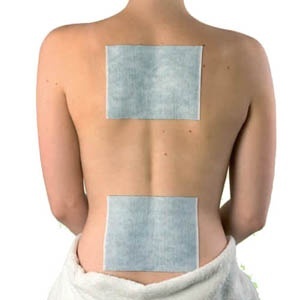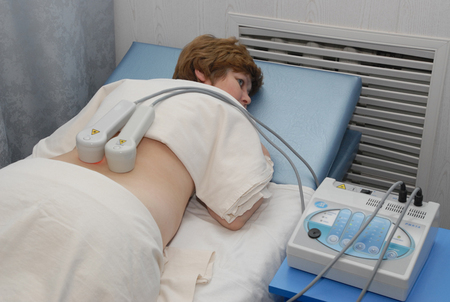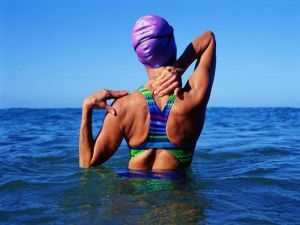 According to statistics, back pain is one of the most common causes of treatment of the adult population to a doctor.
According to statistics, back pain is one of the most common causes of treatment of the adult population to a doctor.
Unfortunately, there is a tendency that such a problem began to occur in people not only at the age after 45, but also much earlier - from about 18 years.
In old age, pain in the back causes discomfort for almost everyone, but only 20-30% treat this problem with a doctor.
There are a lot of reasons for the back disease: it is a sedentary lifestyle associated with the automation of production and the development of technology, this is the excess body weight acquired as a result of malnutrition, it is heredity, it is heavy physical labor, this is the muscle frame weakness and a lot-A lot of other different factors.
It's pain in the back that reduces the work capacity by 40-50%, causes a desire to quickly retire to be able to rest. However, even in retirement, the long-awaited relief does not come.
When experiencing painful and often not passing acute pain in the back, the patient turns to the doctor, who after the examination puts such a terrible diagnosis - "osteochondrosis".What is this disease? Is it curable? Is it possible to prevent its appearance? Is it possible to independently diagnose osteochondrosis? Is it possible to prevent it? Here is a list of questions that interest most patients. Let's understand.
Contents of the article
- Find out the enemy in person
- Which parts of the spine are at stake?
- Swim every day and live to a hundred years
- Even swimming is not always useful
- Before practicing
- General rules
- Task - cervical department
- Thoracic and lumbar approach of another
Know the enemy in person
Osteochondrosis is a disease of the musculoskeletal system, namely:a complex of deformation processes occurring in the cartilaginous tissue of the spine and intervertebral discs leading to a rapid shortening of the spinal column due to the growth of bone tissue and narrowing of the intervertebral disc.
The first signs of the onset of the disease may not necessarily be pain in the cervical, thoracic or lumbar spine. Often, the first bells are frequent headaches, dizziness when turning the head, a sharp increase in blood pressure to critical levels, tinnitus, pain in the abdominal organs, numbness of the upper and lower extremities, worsening of hearing and even fainting.
This is directly related to the violation of blood circulation, and as a result of nutrition of body tissues.
Which parts of the spine are at risk?
Depending on the localization of pain, osteochondrosis can be cervical, thoracic and lumbar, and in the most severe and neglected cases it can affect all parts of the spine: 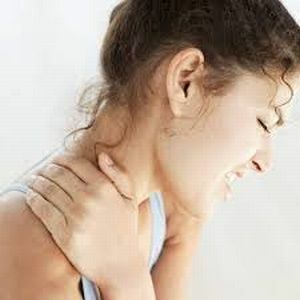
- Cervical - often found, with it displaces the cervical vertebrae, which leads to compression of vessels and nervesthis is evidenced by the appearance of a small hump in the region of the seventh cervical vertebra), causing headache, darkening in the eyes, ringing in the ears.
- Thoracic is less common than the cervical and lumbar, as the thoracic spine is less mobile, its main difference is absence in the back, pain in chest osteochondrosis is not acute, but girdling, which causes discomfort in the sternum and abdominal organs.
- Lumbar is the most common type of osteochondrosis, because the lumbar spine is more mobile than the cervical or thoracic parts. A frequent sign of diseases of the lumbar region is a shooting pain when moving in the sacral region, legs, hips.
A manual therapist, neurologist, orthopedist or vertebrologist can diagnose the disease and prescribe treatment.
To confirm the diagnosis, a number of tests are assigned, among them X-ray, computer-resonance tomography and a number of other clinical studies.
After diagnosis, complex treatment is prescribed. This is a long process that can take many months, and even a year, which requires patient patience and commitment.
As a treatment for osteochondrosis prescribe medications, ointments, acupuncture, massage, diet, exercise therapy and swimming.
Swim every day and live up to a hundred years
It's no secret that swimming has a beneficial effect on the human musculoskeletal system, helps to get rid of a number of problems, such as overweight, high blood pressure, tachycardia, shortness of breath, arrhythmia, helps to cleanextra centimeters and strengthen the abdominal muscles and back.
That's why modern coaches include swimming in the mandatory complex of physiotherapy exercises for diseases of the musculoskeletal system, in particular, for osteochondrosis.
Medical swimming with osteochondrosis allows them to distribute the load evenly to those groups of muscles, where necessary.
Regular training in the pool for osteochondrosis allows to achieve significant results in its treatment, namely: tighten the muscular corset of the back, thoracic and lumbar spine, helps stimulate the breathing system, stretch the vertebrae, "released" the pinched nerves and vessels, stabilize the spinal column, improve muscle tone, improve mood and well-being.
Even swimming is not always useful
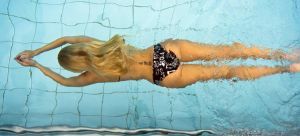 As with the treatment of many diseases, there are certain contraindications to swimming with osteochondrosis.
As with the treatment of many diseases, there are certain contraindications to swimming with osteochondrosis.
In no case should you go swimming during a period of exacerbation of the disease, with acute headache, with high blood pressure, with cardiac, renal, respiratory failure, with any skin diseases, with epilepsy, with any other temporary ailment.
Before practicing
In order to start swimming classes, you must:
- consult your doctor;
- receive a certificate of absence of infectious diseases;
- having received the permission of the doctor and the certificate, to be engaged in search of the instructor and a place for swimming;
- in the nearest shop to buy a swimsuit( give preference to the slender swimsuit), a bathing cap, slippers, a towel, swimming goggles, a nose clip, soap and a loofah( for a shower after the pool).
General rules
To achieve the planned result in the treatment of , swimming lessons should be regular, at least three times a week .
The temperature for swimming by any kind of osteochondrosis should not be lower than 27-30 degrees and not higher than 37 degrees, as the temperature above leads to nervous system excitation.
Task - cervical department of
When osteochondrosis of the cervical spine, as with any other, every swimming session must necessarily begin with 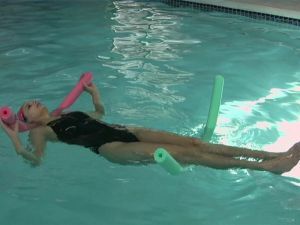 with a little warm-up for warming up the joints and improving blood circulation.
with a little warm-up for warming up the joints and improving blood circulation.
The patient entering the water should warm up and carefully stretch the cervical muscle group by rotating the head and rotating it to the right, left, forward-backward.
Thus, when making swimming movements on the back, the patient leads the muscles into tonus, without overloading the cervical department.
Thoracic and lumbar - the approach of another
In chest and lumbar osteochondrosis it is useful to hang in water on the crossbar. The benefit is the stretching of the thoracic and lumbar vertebrae with a minimum weight load on them.
In addition, it is useful to perform the following exercises: swimming with a cushion in your hands, swimming with a cushioned foot, swimming with a breaststroke with a delay in breathing, protrusion of the abdomen in the water, slow squats in the water with legs apart, forward deflections with hands on the belt.
 The recommended type of swimming for osteochondrosis of the thoracic and lumbar region is the breast, it allows you to keep the body in a horizontal position, using the maximum number of muscles of all groups.
The recommended type of swimming for osteochondrosis of the thoracic and lumbar region is the breast, it allows you to keep the body in a horizontal position, using the maximum number of muscles of all groups.
The rhythm plays a big role in swimming, there should not be any sudden movements, the rhythm is based on a deep breath and a sharp exhalation.
Thus, regular sessions in the pool, at a clearly defined time together with medical and other therapy and under the strict supervision of the instructor will help in the shortest time to succeed.
Remember to consult a doctor and prescribe a comprehensive treatment and be healthy!

